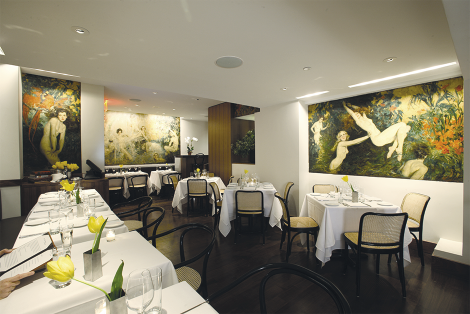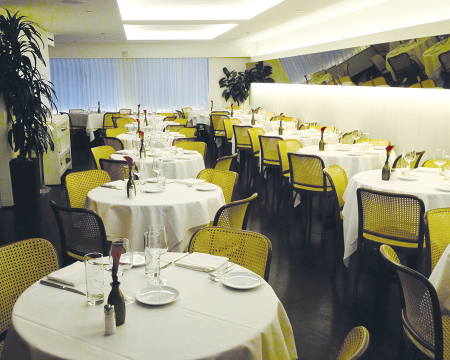- Home
- Media Kit
- Current Issue
- Past Issues
- Ad Specs-Submission
- Ad Print Settings
- Reprints (PDF)
- Photo Specifications (PDF)
- Contact Us

![]()
ONLINE

Italian Hospitality
Editors’ Note
Originally from Naples, Italy, Gianfranco Sorrentino carries over 35 years of experience in restaurant management at properties including Quisitana Hotel in Capri, Dorchester Hotel in London, Four Seasons Hotel in Tokyo, Bice Restaurant in New York, Sette MoMA Restaurant at The Museum of Modern Art of New York, Union Bar and Grill in Great Barrington, Massachusetts, and The Leopard at des Artistes in the New York landmark the Hotel des Artistes. In September 2001, he opened Il Gattopardo, just across the street from MoMA, along with his wife Paula Bolla and his talented Executive Chef Vito Gnazzo.
Prior to assuming her current role, Paula Bolla-Sorrentino was a designer at Pentagram Design and handled special events at Sette MoMA. She is a graduate of the Fashion Institute of Technology with a B.F.A. in graphic design.
Company Brief
Il Gattopardo (ilgattopardonyc.com) serves traditional Southern Italian comfort food that has been adapted for the contemporary palate without compromising the authenticity of the cuisine. Il Gattopardo is committed to producing top quality Southern Italian gastronomy, to using authentic ingredients, and to keeping the tradition of Italian culture and hospitality vibrant and passionate. After 12 years at its original location, the restaurant has a new home at The Rockefeller Townhouses.
The Leopard at des Artistes (theleopardnyc.com) is located in one of the most iconic spaces in New York City, the Hotel des Artistes. The Leopard finds its roots in the area once known as “The Kingdom of the Two Sicilies” and in the culinary traditions of the regions of Campania, Basilicata, Calabria, Apulia, Sardinia, and Sicily. The dishes are a balance of rural elements from these regions and include pasta, vegetables, cheese, and seafood ingredients from the Costiera.
Mozzarella & Vino (mozzarellaevino.com), located in the former space of Il Gattopardo, across from MoMA on 54th Street, is the more rustic and casual sibling. Its concept reflects the simplicity of authentic Italian ingredients, with a heavy emphasis on the Mozzarella di bufala Campana, Italian cheeses, and affettati. The enoteca style bar focuses on showcasing rather smaller family estates and independent Italian winemakers with history, quality, and good value.
What has made your restaurants so special?
Paula: There are many great restaurants in New York that offer great service and wonderful cuisine, but we stand out in consistence and hospitality, and when people visit us, they can expect to be treated like part of our family. We receive our loyal customers as if they are coming to our house.

The Leopard at des Artistes
Would you talk about the importance of the new space and have you been happy with the reception from the guests?
Gianfranco: The space gives us a great opportunity to expand our sense of hospitality. We have a small but cozy bar and about 90 seats. When a restaurant goes over 100 seats, it’s a different ballgame. You have to prep a lot and assemble at the moment. You can’t cook at the moment, which is what we like to do.
We have a great room downstairs to cater private parties, where we can also serve anything we serve upstairs.
How important is it to continue to innovate with your cuisine and keep the menu fresh?
Gianfranco: We go to Italy at least once or twice a year so we can research new products and dishes. We have tremendous respect for the ingredients.
We still believe in seasonal cuisine. If an ingredient is good in the summer, it makes no sense to serve it any other time. This is what keeps us contemporary.
But we also have some dishes that are classic, which our customers come for, like the Neapolitan Meatloaf and the Spigola.
Paula: There are some items we cannot take off the menu. If we do, we’re in trouble with our guests. We’ve just began our fall and winter menu, in which we have some new exciting additions, but what makes it so special is the simplicity of the ingredients – if you don’t understand what you are eating, well, that’s not good.

Il Gattopardo
Is recruiting staff mostly about personality? When do you know someone will be a good fit?
Gianfranco: I can teach them the service but I cannot teach them hospitality – to welcome our customers with the heart and not with the brain.
We’re looking for the people who can also manage themselves. They are looking to do the job and not waiting for me to tell them to do this or that.
We try to overload the staff initially, and if they respond well and can handle it, this is a good sign. If they start to short-cut or get lazy, that’s not a good sign.
What plans do you have to continue to strengthen The Leopard?
Gianfranco: The Leopard is in one of the most historic locations in New York. It was very challenging when we opened up because everybody was concerned about what we were going to do with this historic place. It was a 60-year-old restaurant and when we demolished it, we found things we didn’t want to find.
One of our most important focuses was to restore the murals. We were lucky because we had a restaurant in the Museum of Modern Art and we still have a good relationship with them, so one of the curators suggested a wonderful Art Conservation company, Rustin Levenson, to take care of the murals. We had people from their firm in before the renovation, to protect the pieces during the demolition, and we had them back afterwards for the full restoration project. The conservation artists came over and put the scaffolding down, and with a small brush and small sponge, they started to clean it up. One of the big murals was in such bad shape that we had to box it up and send it out for full cleanup and reinforcement.
Paula: It was a fascinating project, but long (and for us nerve-racking) When we had our opening party, they were still working on the scaffolding. It became one of the entertainment points of the party because the restoration was still going on – the murals are wonderful, from the 1920s, and they’re part of the history of New York, and you could clearly see the difference when they were restored. Offreing our guests great food and wine with an art show was quite a treat.
Gianfranco: Regarding how we keep it up, we try to make it different because we have a lot of clients that come here for both lunch and dinner, so the menu is diverse, within our common goal and our concept. It comes down to the cuisine and to the freshness of the ingredients and the simplicity of a dish’s preparation. It’s a different menu but the heart is very much the same. It’s all served with an Italian hospitality.•